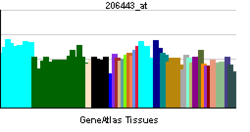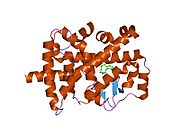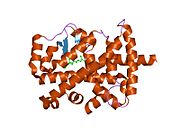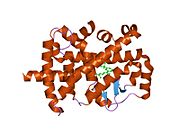- RAR-related orphan receptor beta
-
RAR-related orphan receptor beta (ROR-beta), also known as NR1F2 (nuclear receptor subfamily 1, group F, member 2) is a nuclear receptor that in humans is encoded by the RORB gene.[1]
Contents
Function
The protein encoded by this gene is a member of the NR1 subfamily of nuclear hormone receptors. It is a DNA-binding protein that can bind as a monomer or as a homodimer to hormone response elements upstream of several genes to enhance the expression of those genes. The specific functions of this protein are not known, but it has been shown to interact with NM23-2, a nucleoside-diphosphate kinase involved in organogenesis and differentiation.[2]
Interactions
RAR-related orphan receptor beta has been shown to interact with NME1.[3]
See also
References
- ^ Giguère V, Tini M, Flock G, Ong E, Evans RM, Otulakowski G (March 1994). "Isoform-specific amino-terminal domains dictate DNA-binding properties of ROR alpha, a novel family of orphan hormone nuclear receptors". Genes Dev. 8 (5): 538–53. doi:10.1101/gad.8.5.538. PMID 7926749.
- ^ "Entrez Gene: RORB RAR-related orphan receptor B". http://www.ncbi.nlm.nih.gov/sites/entrez?Db=gene&Cmd=ShowDetailView&TermToSearch=6096.
- ^ Paravicini G, Steinmayr M, André E, Becker-André M (October 1996). "The metastasis suppressor candidate nucleotide diphosphate kinase NM23 specifically interacts with members of the ROR/RZR nuclear orphan receptor subfamily". Biochem. Biophys. Res. Commun. 227 (1): 82–7. doi:10.1006/bbrc.1996.1471. PMID 8858107.
Further reading
- Beeson WM, Perry TW, Zurcher TD (1977). "Effect of supplemental zinc on growth and on hair and blood serum levels of beef cattle.". J. Anim. Sci. 45 (1): 160–5. PMID 885817.
- Carlberg C, Hooft van Huijsduijnen R, Staple JK, et al. (1994). "RZRs, a new family of retinoid-related orphan receptors that function as both monomers and homodimers.". Mol. Endocrinol. 8 (6): 757–70. doi:10.1210/me.8.6.757. PMID 7935491.
- Greiner EF, Kirfel J, Greschik H, et al. (1996). "Functional analysis of retinoid Z receptor beta, a brain-specific nuclear orphan receptor.". Proc. Natl. Acad. Sci. U.S.A. 93 (19): 10105–10. doi:10.1073/pnas.93.19.10105. PMC 38344. PMID 8816759. http://www.pubmedcentral.nih.gov/articlerender.fcgi?tool=pmcentrez&artid=38344.
- Paravicini G, Steinmayr M, André E, Becker-André M (1996). "The metastasis suppressor candidate nucleotide diphosphate kinase NM23 specifically interacts with members of the ROR/RZR nuclear orphan receptor subfamily.". Biochem. Biophys. Res. Commun. 227 (1): 82–7. doi:10.1006/bbrc.1996.1471. PMID 8858107.
- Bonaldo MF, Lennon G, Soares MB (1997). "Normalization and subtraction: two approaches to facilitate gene discovery.". Genome Res. 6 (9): 791–806. doi:10.1101/gr.6.9.791. PMID 8889548.
- Park HT, Baek SY, Kim BS, et al. (1997). "Developmental expression of 'RZR beta, a putative nuclear-melatonin receptor' mRNA in the suprachiasmatic nucleus of the rat.". Neurosci. Lett. 217 (1): 17–20. doi:10.1016/S0304-3940(96)13060-3. PMID 8905729.
- André E, Conquet F, Steinmayr M, et al. (1998). "Disruption of retinoid-related orphan receptor beta changes circadian behavior, causes retinal degeneration and leads to vacillans phenotype in mice.". EMBO J. 17 (14): 3867–77. doi:10.1093/emboj/17.14.3867. PMC 1170722. PMID 9670004. http://www.pubmedcentral.nih.gov/articlerender.fcgi?tool=pmcentrez&artid=1170722.
- Greiner EF, Kirfel J, Greschik H, et al. (2000). "Differential ligand-dependent protein-protein interactions between nuclear receptors and a neuronal-specific cofactor.". Proc. Natl. Acad. Sci. U.S.A. 97 (13): 7160–5. doi:10.1073/pnas.97.13.7160. PMC 16516. PMID 10860982. http://www.pubmedcentral.nih.gov/articlerender.fcgi?tool=pmcentrez&artid=16516.
- Gawlas K, Stunnenberg HG (2001). "Differential binding and transcriptional behaviour of two highly related orphan receptors, ROR alpha(4) and ROR beta(1).". Biochim. Biophys. Acta 1494 (3): 236–41. PMID 11121580.
- Gawlas K, Stunnenberg HG (2001). "Differential transcription of the orphan receptor RORbeta in nuclear extracts derived from Neuro2A and HeLa cells.". Nucleic Acids Res. 29 (16): 3424–32. doi:10.1093/nar/29.16.3424. PMC 55847. PMID 11504880. http://www.pubmedcentral.nih.gov/articlerender.fcgi?tool=pmcentrez&artid=55847.
- Stehlin C, Wurtz JM, Steinmetz A, et al. (2001). "X-ray structure of the orphan nuclear receptor RORbeta ligand-binding domain in the active conformation.". EMBO J. 20 (21): 5822–31. doi:10.1093/emboj/20.21.5822. PMC 125710. PMID 11689423. http://www.pubmedcentral.nih.gov/articlerender.fcgi?tool=pmcentrez&artid=125710.
- Sumi Y, Yagita K, Yamaguchi S, et al. (2002). "Rhythmic expression of ROR beta mRNA in the mice suprachiasmatic nucleus.". Neurosci. Lett. 320 (1–2): 13–6. doi:10.1016/S0304-3940(02)00011-3. PMID 11849752.
- Strausberg RL, Feingold EA, Grouse LH, et al. (2003). "Generation and initial analysis of more than 15,000 full-length human and mouse cDNA sequences". Proc. Natl. Acad. Sci. U.S.A. 99 (26): 16899–903. doi:10.1073/pnas.242603899. PMC 139241. PMID 12477932. http://www.pubmedcentral.nih.gov/articlerender.fcgi?tool=pmcentrez&artid=139241.
- Stehlin-Gaon C, Willmann D, Zeyer D, et al. (2003). "All-trans retinoic acid is a ligand for the orphan nuclear receptor ROR beta". Nat. Struct. Biol. 10 (10): 820–5. doi:10.1038/nsb979. PMID 12958591.
- Humphray SJ, Oliver K, Hunt AR, et al. (2004). "DNA sequence and analysis of human chromosome 9". Nature 429 (6990): 369–74. doi:10.1038/nature02465. PMC 2734081. PMID 15164053. http://www.pubmedcentral.nih.gov/articlerender.fcgi?tool=pmcentrez&artid=2734081.
External links
PDB gallery Transcription factors and intracellular receptors (1) Basic domains Activating transcription factor (AATF, 1, 2, 3, 4, 5, 6, 7) · AP-1 (c-Fos, FOSB, FOSL1, FOSL2, JDP2, c-Jun, JUNB, JUND) · BACH (1, 2) · BATF · BLZF1 · C/EBP (α, β, γ, δ, ε, ζ) · CREB (1, 3, L1) · CREM · DBP · DDIT3 · GABPA · HLF · MAF (B, F, G, K) · NFE (2, L1, L2, L3) · NFIL3 · NRL · NRF (1, 2, 3) · XBP1ATOH1 · AhR · AHRR · ARNT · ASCL1 · BHLHB2 · BMAL (ARNTL, ARNTL2) · CLOCK · EPAS1 · FIGLA · HAND (1, 2) · HES (5, 6) · HEY (1, 2, L) · HES1 · HIF (1A, 3A) · ID (1, 2, 3, 4) · LYL1 · MESP2 · MXD4 · MYCL1 · MYCN · Myogenic regulatory factors (MyoD, Myogenin, MYF5, MYF6) · Neurogenins (1, 2, 3) · NeuroD (1, 2) · NPAS (1, 2, 3) · OLIG (1, 2) · Pho4 · Scleraxis · SIM (1, 2) · TAL (1, 2) · Twist · USF1(1.4) NF-1(1.5) RF-X(1.6) Basic helix-span-helix (bHSH)(2) Zinc finger DNA-binding domains subfamily 1 (Thyroid hormone (α, β), CAR, FXR, LXR (α, β), PPAR (α, β/δ, γ), PXR, RAR (α, β, γ), ROR (α, β, γ), Rev-ErbA (α, β), VDR)
subfamily 2 (COUP-TF (I, II), Ear-2, HNF4 (α, γ), PNR, RXR (α, β, γ), Testicular receptor (2, 4), TLX)
subfamily 3 (Steroid hormone (Androgen, Estrogen (α, β), Glucocorticoid, Mineralocorticoid, Progesterone), Estrogen related (α, β, γ))
subfamily 4 NUR (NGFIB, NOR1, NURR1) · subfamily 5 (LRH-1, SF1) · subfamily 6 (GCNF) · subfamily 0 (DAX1, SHP)(2.2) Other Cys4(2.3) Cys2His2General transcription factors (TFIIA, TFIIB, TFIID, TFIIE (1, 2), TFIIF (1, 2), TFIIH (1, 2, 4, 2I, 3A, 3C1, 3C2))
ATBF1 · BCL (6, 11A, 11B) · CTCF · E4F1 · EGR (1, 2, 3, 4) · ERV3 · GFI1 · GLI-Krüppel family (1, 2, 3, REST, S2, YY1) · HIC (1, 2) · HIVEP (1, 2, 3) · IKZF (1, 2, 3) · ILF (2, 3) · KLF (2, 3, 4, 5, 6, 7, 8, 9, 10, 11, 12, 13, 14, 15, 17) · MTF1 · MYT1 · OSR1 · PRDM9 · SALL (1, 2, 3, 4) · SP (1, 2, 4, 7, 8) · TSHZ3 · WT1 · Zbtb7 (7A, 7B) · ZBTB (16, 17, 20, 32, 33, 40) · zinc finger (3, 7, 9, 10, 19, 22, 24, 33B, 34, 35, 41, 43, 44, 51, 74, 143, 146, 148, 165, 202, 217, 219, 238, 239, 259, 267, 268, 281, 295, 300, 318, 330, 346, 350, 365, 366, 384, 423, 451, 452, 471, 593, 638, 644, 649, 655)(2.4) Cys6(2.5) Alternating composition(3) Helix-turn-helix domains ARX · CDX (1, 2) · CRX · CUTL1 · DBX (1, 2) · DLX (3, 4, 5) · EMX2 · EN (1, 2) · FHL (1, 2, 3) · HESX1 · HHEX · HLX · Homeobox (A1, A2, A3, A4, A5, A7, A9, A10, A11, A13, B1, B2, B3, B4, B5, B6, B7, B8, B9, B13, C4, C5, C6, C8, C9, C10, C11, C12, C13, D1, D3, D4, D8, D9, D10, D11, D12, D13) · HOPX · IRX (1, 2, 3, 4, 5, 6, MKX) · LMX (1A, 1B) · MEIS (1, 2) · MEOX2 · MNX1 · MSX (1, 2) · NANOG · NKX (2-1, 2-2, 2-3, 2-5, 3-1, 3-2, 6-1, 6-2) · NOBOX · PBX (1, 2, 3) · PHF (1, 3, 6, 8, 10, 16, 17, 20, 21A) · PHOX (2A, 2B) · PITX (1, 2, 3) · POU domain (PIT-1, BRN-3: A, B, C, Octamer transcription factor: 1, 2, 3/4, 6, 7, 11) · OTX (1, 2) · PDX1 · SATB2 · SHOX2 · VAX1 · ZEB (1, 2)(3.2) Paired box(3.5) Tryptophan clusters(3.6) TEA domain(4) β-Scaffold factors with minor groove contacts (4.1) Rel homology region(4.3) p53(4.7) High-mobility group(4.10) Cold-shock domainCSDA, YBX1(4.11) Runt(0) Other transcription factors (0.2) HMGI(Y)(0.6) MiscellaneousCategories:- Human proteins
- Chromosome 9 gene stubs
- Intracellular receptors
- Transcription factors
Wikimedia Foundation. 2010.





